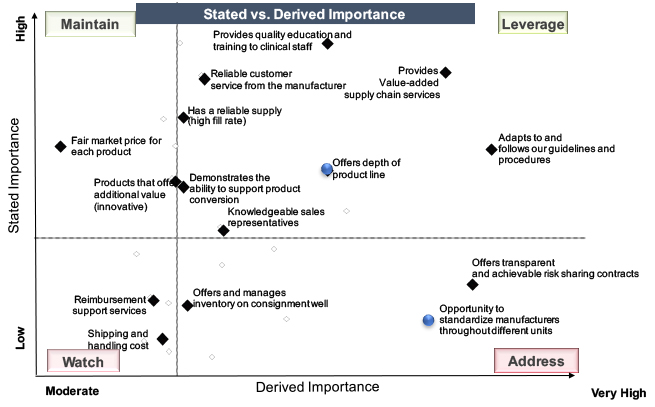Case studies
Let’s explore three case studies to illustrate the value of conducting market research.
Case study 1. A start-up medical device company is developing a catheter used after acute myocardial infarction. They are two years away from applying to the FDA for pre-market approval (PMA) and a few months away from starting final clinical trials to support the PMA.
The company would like to understand which clinical trial endpoints will maximize access to, and adoption by, hospitals and physicians, and deliver the best possible coverage and reimbursement from payers. In addition to optimizing the design of its clinical trials, the market research will help the company craft its messaging.
To achieve these objectives, the company conducted a series of five telephone interviews with medical directors at private payers offering commercial and Medicare Advantage products and an Internet survey with 30 hospital purchasing and clinical executives. The sample was designed to reflect the company’s need to efficiently use available funds to deliver directional results.
The study’s results focused the company’s attention on a subset of endpoints that they thought would be of interest to payers and hospital decision makers. The feedback also affected the duration of the clinical trial. Investing in market research, in the end, enhanced the likelihood of success for its product and saved money by getting its messaging and pricing right the first time.
Case study 2. A company was developing a digital-based healthcare product to better manage respiratory conditions. The company sought to determine how to position their sensor and data-management system for coverage. Conducting research with four payer executives uncovered unexpected avenues to gain coverage and opportunities to partner with payers to support utilization of their product. The company changed their marketing strategies to take advantage of these unexpected opportunities.
Case study 3. A large medical device company sought to understand the drivers of decisions made by hospital-based value analysis committees. An Internet survey with 150 purchasing and clinical executives delivered these insights. As illustrated below, the study gathered these executives’ stated decision drivers as well as the derived decision drivers.
Stated decision drivers are the factors that an executive will tell you are important to their decision.
Derived decision drivers are those that are inferred from the actions an executive takes. In this study, we determined the market share awarded to each manufacturer. We also asked each executive to rank each manufacturer’s performance on each of 15 potential decision drivers. Through statistical analysis, we tied each manufacturer’s relative market share to their performance on each decision driver to determine the relative importance of each decision driver.
For example, if manufacturers A and B have the largest market share and both are leaders in supply chain management systems, then “Effectiveness of Supply Chain Management System Systems” is an important decision driver. If manufacturers C and D have the least market share and both emphasize low prices, then “Low Pricing” is not an important decision driver.
As Figure 1 illustrates, stated and derived drivers differ. Both need to be addressed in marketing strategies and tactics. (Note: The data presented in Figure 1 are for illustrative purposes only. The study’s actual results are proprietary.)
For example, Figure 1 indicates that risk-sharing contracts are more important than customers might state. Therefore, it is a “hidden” driver that manufacturers should address by developing innovative risk-sharing arrangements. Doing so would differentiate the manufacturer from competitors and position them for success.

In contrast, fair market price is stated as important but does not drive relative market share (as stated above, these results are disguised). Therefore, cost leadership strategies are a formula for poor market share performance. The manufacturer should not invest extensively in innovative pricing strategies.
The large medical device company also sought to determine how its corporate brand compared to that of its competitors as perceived by hospital-based value analysis committees. A market research-based analysis yielded the perceptual map shown in Figure 2. The map shows that the large medical device company (indicated as “Client”) has a brand that is similar to that of Competitor 2. Both excel at innovative contracting and following guidelines. Competitors 3 through 7 have carved out a different market position. Hospital executives cannot clearly define Competitor 8’s brand.

Figure 2 shows that no competitor’s brand is clearly defined by its payment terms or reimbursement support services. These are opportunities to stake out unique market positions. However, competitors should refer to the driver chart to determine their value to clients and take into account their resources and abilities to capitalize on these unmet market needs.
Conclusion
As these few examples illustrate, well-designed market research can generate a significant return on investment. Research can expedite product launch timeframes and optimize revenue and market share through optimal pricing and competitive positioning. As markets become more competitive and investors demand quicker and bigger returns, market research can be an overlooked opportunity to come out a winner.
The design of the market research will weigh budget considerations versus objectives. A great deal can be achieved within a wide budgetary range. Therefore, there are opportunities to enhance marketing and sales strategies within a budget that meets most company’s needs.






